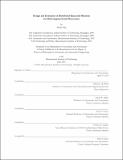| dc.contributor.advisor | Olivier L. de Weck. | en_US |
| dc.contributor.author | Nag, Sreeja | en_US |
| dc.contributor.other | Massachusetts Institute of Technology. Department of Aeronautics and Astronautics. | en_US |
| dc.date.accessioned | 2015-09-17T17:44:31Z | |
| dc.date.available | 2015-09-17T17:44:31Z | |
| dc.date.copyright | 2015 | en_US |
| dc.date.issued | 2015 | en_US |
| dc.identifier.uri | http://hdl.handle.net/1721.1/98586 | |
| dc.description | Thesis: Ph. D., Massachusetts Institute of Technology, Department of Aeronautics and Astronautics, 2015. | en_US |
| dc.description | This electronic version was submitted by the student author. The certified thesis is available in the Institute Archives and Special Collections. | en_US |
| dc.description | Cataloged from student-submitted PDF version of thesis. | en_US |
| dc.description | Includes bibliographical references (pages 225-238). | en_US |
| dc.description.abstract | Distributed Spacecraft Missions (DSMs) are gaining momentum in their application to Earth science missions owing to their ability to increase observation sampling in spatial, spectral and temporal dimensions. This thesis identifies a gap in the angular sampling abilities of monolithic spacecraft in Earth observation missions and proposes to use distributed spacecraft to address this gap. The science performance metric is chosen to be Bidirectional Reflectance-Distribution Function (BRDF), which describes the directional and spectral variation of reflectance of an optically thick surface element at any time instant. Airborne instruments are the gold standard for BRDF estimation (e.g. Cloud Absorption Radiometer/CAR). They can collect thousands of reflectance measurements at the same ground spot, but are localized in space and time. Spaceborne platforms estimate BRDF by combining angular measurements over time, made along-track, cross-track or by autonomous pointing. However, their plane of data acquisition is very restricted with respect to the sun and the target itself might change over time of acquisition. Formations with spectrometer payloads can make multi-spectral reflectance measurements of a ground target, at many zenith and azimuthal angles simultaneously and estimate the angular signature of the surface. Constellations with overlapping ground spots can capture the angular components of global and temporally varying science products. This work demonstrates the performance impact and feasibility of a BRDF estimation mission using a systems engineering tool (driven by model based systems engineering or MBSE), intricately coupled with a science evaluation tool (driven by observing system simulation experiments or OSSEs). Formations and payload pointing strategies are optimized to maximize angular spread and minimize estimation errors. The effect of angular spread on spatial, spectral and radiometric sampling dimensions is quantified for available spectrometer payloads that fit within the 6U CubeSat standard. Technical feasibility within 6U is verified for attitude determination and control, propulsion, communication and onboard processing modules. DSM architectures are generated and compared to each other and monoliths, in terms of BRDF, albedo, gross primary productivity and total outgoing radiation. Performance is benchmarked with respect to data from previous airborne campaigns (NASA CAR), tower measurements (AMSPEC II) and ideal values from radiative transfer or climate models (UMGLO, COART); and accepted BRDF models. A formation of 6 small satellites produces lesser average error (21.82%) than larger monoliths (23.2%) over extended time periods, purely in terms of angular sampling benefits. The monolithic albedo error of 3.6% is shown to be outperformed by a formation of 3 satellites (1.86%), when arranged optimally and by a formation of 5 satellites (3.36%) when arranged in any way. An 8-satellite formation pushes albedo errors to 0.67% and reduces gross primary productivity errors from 89.77% (monolithic) to 78.69%. | en_US |
| dc.description.statementofresponsibility | by Sreeja Nag. | en_US |
| dc.format.extent | 243 pages | en_US |
| dc.language.iso | eng | en_US |
| dc.publisher | Massachusetts Institute of Technology | en_US |
| dc.rights | M.I.T. theses are protected by copyright. They may be viewed from this source for any purpose, but reproduction or distribution in any format is prohibited without written permission. See provided URL for inquiries about permission. | en_US |
| dc.rights.uri | http://dspace.mit.edu/handle/1721.1/7582 | en_US |
| dc.subject | Aeronautics and Astronautics. | en_US |
| dc.title | Design and evaluation of distributed spacecraft missions for multi-angular Earth observation | en_US |
| dc.type | Thesis | en_US |
| dc.description.degree | Ph. D. | en_US |
| dc.contributor.department | Massachusetts Institute of Technology. Department of Aeronautics and Astronautics | |
| dc.identifier.oclc | 921146670 | en_US |
